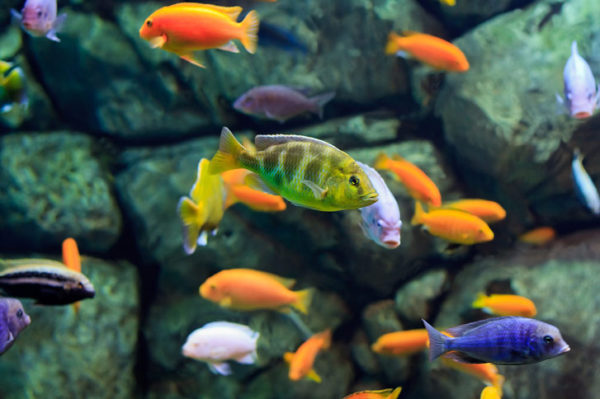
Lake Malawi Cichlids
Where is Lake Malawi
Lake Malawi is the 5th biggest lake by volume and the 9th largest by size. Lake Malawi is a rift valley lake and also an ancient lake. The lake lies in a valley formed millions of years ago by the opening of the east African rift where the African tectonic plates split in two pieces.

Lake Malawi Cichlid water chemistry
The water in the lake is very hard, alkaline of between a pH of 7.7 to 8.6 with a typical temperature of 24 °C to 30 °C at the surface and the temperature drops as you go down in depth. The lake does have a thermocline at around 40 meters so keeping most of the fish species above that level. Tap water is ideal for Malawi species especially in Dorset as we have very hard water (always check your local tap water to see if its soft or hard)
What size aquarium do I need?
Malawi cichlids will grow between 10-40cm so the larger you go the better it is for them. I would suggest nothing smaller then 125 litres with a big and powerful external canister filter.

Ideal habitat for Malawi cichlids
Lake Malawi its self is very rocky with very little vegetation. Use ocean rock and other larger rocks that aren't sharp, If you are going to stack the rocks ensure they wont fall and hit the glass as Malawi cichlids like to dig, you can use a poxy resin to attach in place. Substrate wise coral sand or fine gravel works really well as it allows the cichlids to pick it up and move it without the filter sucking it up like fine sand.

What fish can I have?
You will find over 800 species of cichlids in the lake and these are normally refereed to as Peacocks, Haps, Nimbochromis and Mbuna. Peacocks, Haps etc can be very colourful especially the males, the females are darker. This species of fish spend more time in the open. Mbuna are known as rock dwelling so ensure lots of rock is provided for them to swim in and out of. You can mix Malawi cichlids but always check with your local store what goes best with each other as cichlids are aggressive and it can go very wrong if the right advice isn't given. The key to a good Malawi aquarium is research the more you do the more success you will have.
Will Malawi Cichlids breed?
The simple answer is yes as long as you have the right environment for them and for the fry to hatch. Mbuna species are mouth brooders, this means the female incubates her eggs in her mouth. The male will normally encourage the female by displaying colour and chasing her around. The female releases the eggs and the male fertilizes them, she will gather them carefully in her mouth. The eggs will remain inside the female's mouth until they hatch into fry. Peacocks Malawi are egg layers, the female will lay the eggs and the male fertilise them, the female will guard them until they hatch.
What do I feed my cichlids?
Malawi cichlids do like a varied diet, Personally I feed mine on a mix of cichlid pellets, granular or sticks depending on the size of the fish. Also a malawi flake food as this contains the correct Ingredients for a varied diet.
My personal favourite species
The Venustus Cichlid (Nimbochromis venustus), You will also find it called the Giraffe Hap or Giraffe Cichlid. This species are easily identified by their unique green pattern. The pattern resembles the markings of a giraffe, hence the name "giraffe cichlid". This species are highly intelligent, using a special hunting technique where they submerge themselves entirely in the sand after spotting prey and will lie still, waiting for unsuspecting small fish to swim close. The smaller fish will then examine the ‘dead’ fish, which is when the Venustus Cichlid darts out of the sand to eat them. They can grow upto 30cm so a larger aquarium over 200 litres is required.

